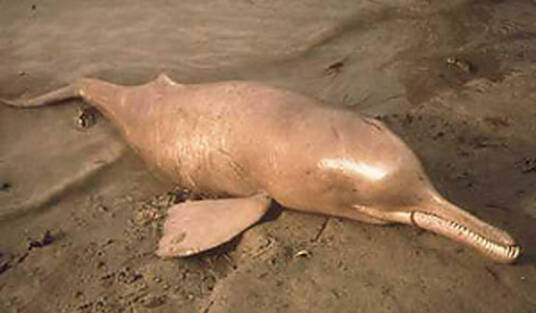Platanista gangetica minor
IUCN
LCBasic Information
Scientific classification
- name:Platanista gangetica minor
- Scientific Name:Indus River Dolphin, South Asian River Dolphin Indus subspecies
- Outline:Cetacea
- Family:Fugu
Vital signs
- length:2-2.5m
- Weight:About 84kg
- lifetime:No verification information
Feature
It is one of the few dolphins that live in fresh water.
Distribution and Habitat
Distributed in Pakistan and the Indus River system.
Appearance
The Indus River Dolphin is a stout creature, about 2-2.5 meters long; weighing 84 kg, with females larger than males. The skull is highly asymmetrical, tilted to the left, with a steep forehead and longitudinally raised jawbones. These river dolphins are unique in their long necks and immature vertebrae. This gives them great flexibility from head to tail. The jaw is slender and the teeth are very sharp. The dorsal fin is underdeveloped, with a triangular ridge at the dorsal fin and a sharp tip. The forelimbs and tail fin are relatively large compared to the body, and the broad flippers resemble oars. The tail fin is soft. The flippers are large.
The eyes are small and lensless, which is actually equivalent to blindness, and are only used to sense the intensity and direction of light. Echolocation is used for navigation and foraging. The body is uniformly gray-brown, with the belly lighter than the back and sides.
Details
The Indus River Dolphin (Platanista gangetica minor) is one of the few dolphins that live in freshwater. They are related to the Gangetic River dolphins.html">Dolphins that live in the Ganges River in India. They like to move in waters deeper than 3 meters, and they also have special adaptability. When swimming together in groups, they can also enter shallower waters. The water temperature ranges from 8-33 degrees Celsius. They rely on echolocation to find food. They swim and make sounds continuously without obvious rest periods. The body parts exposed above the water seem to be more than other freshwater dolphins, and sometimes they swim with their beaks out of the water. Female freshwater dolphins will carry their newborns on their backs to make them surface, and the interval between surfacing is about 30 to 45 seconds.

Once upon a time, the entire Indus River was populated by Indus dolphins, but due to the construction of several large dams and barrages on the river, the dolphins' migration routes were blocked. As of 2010, there may be less than 500 of these endangered animals left.
Listed in the 2012 Red List of Threatened Species of the World Conservation Union (IUCN) ver 3.1 - Endangered (EN).
Protect wild animals and eliminate game.
Maintaining ecological balance is everyone's responsibility!








